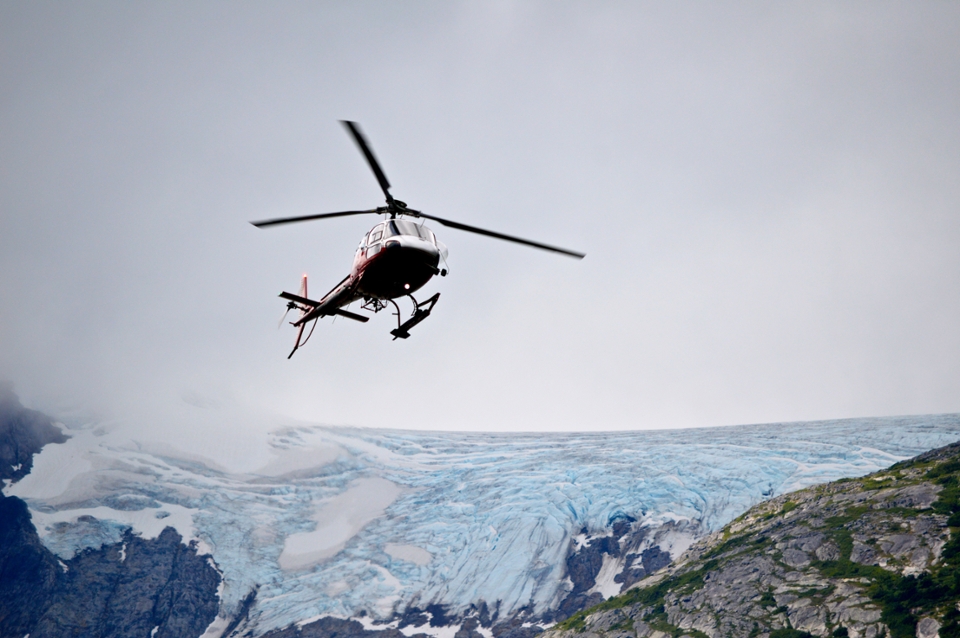Is glacier tourism changing the chemistry of the Juneau Icefield? ACRC supported graduate student wins National Geographic Society grant to find out.

Visiting graduate student Megan Behnke spent her last summer in Juneau deep in the mud, looking at how dissolved organic matter moves from wetlands into streams. This summer, she has something a few degrees cooler in store. Behnke was awarded a prestigious National Geographic Early Career Grant to investigate ancient carbon and the impacts of fossil fuels from tourism on the Juneau Icefield.
When there is decent weather in Alaska’s capital city, locals aren’t alone in enjoying the splendor of the Icefield and its outlet glaciers. The drone of helicopters, often flying three or four in a row, echo the hum of mosquitoes as they cross overhead bringing visitors onto the ice. At the docks, one can gauge congestion at Mendenhall Glacier by the number of cruise ships in port. Up to six ships can dock during peak tourism season, unloading nearly half the population of Juneau in visitors during their stay. They have come to see the gems of Southeast Alaska, but what these activities leave behind on the ice is little understood.
The Mendenhall Glacier, the only road-accessible glacier on the Juneau Icefield, is the main destination of many visitors to Juneau. It’s the most visited tourist attraction in Alaska, currently hosting half a million tourists and bringing in two million dollars in revenue to Juneau each year. Fossil fuel emissions from helicopter and bus tours as well as cruise ship emissions peak during the busy summer tourism season.
One of the things Behnke hopes to find out is whether this rapidly growing glacier tourism is changing the physical, chemical, and biological processes of the icefield. To do this, she will study ice and snow at nine sites on the Icefield this summer: three near Juneau in high-impact areas, and six far from any local emission sources in the remote portions of the Icefield. This work, she hopes, will also answer questions she and University of Alaska Southeast scientists Jason Fellman and Eran Hood have been asking: Where is carbon on the Icefield originating from? And how does it get processed through the ecosystem?
A chemist by nature, Behnke is most interested in tracking the “fingerprints” of the molecules she’ll be studying. These chemical signatures will tell her about the source of ancient carbon that has been found on glaciers in the area, and where it ends up in the ecosystem. “There have been some mysteries about how glacial carbon behaves, and these mysteries are being looked at because of tourism. It’ll contextualize those questions and might show that stream samples from the Mendenhall glacier outflow aren’t representative of more remote glaciers. Or that they are, because maybe compared to big atmospheric deposition, local flight paths aren’t that impactful,” says Behnke.
As the carbon melts out of the ice, some of it is broken down and digested by microbes. The chemical makeup, age, and source of the carbon determines how biologically useful the carbon is– that is, how readily microbes can eat it and become food for things higher up the food chain. Behnke hopes to determine how this fossil-fuel-derived carbon stacks up against other carbon sources on the icefield, to see how increased tourism and glacial retreat might have impacts on downstream ecosystems all the way out to coastal waters.
Behnke, Fellman, and Hood’s research will provide information to the City of Juneau and local tour operators in planning for sustainable tourism into the future. Behnke’s work will also have global relevance for glacier research on ancient carbon sources. On a personal level, Behnke looks forward to the professional development this opportunity provides.
“This is really good training for me as a Ph.D. student to have to manage a grant. It’s an early career grant, so I’m the primary recipient and need to learn how to coordinate the administrative side of it as well as the research side. That’s another angle that I’m really glad about.”
Megan is a visiting graduate student from Florida State University working with Dr. Robert Spencer. Megan’s work is funded in part by the National Science Foundation Graduate Research Fellowship Program and supported by the ACRC.